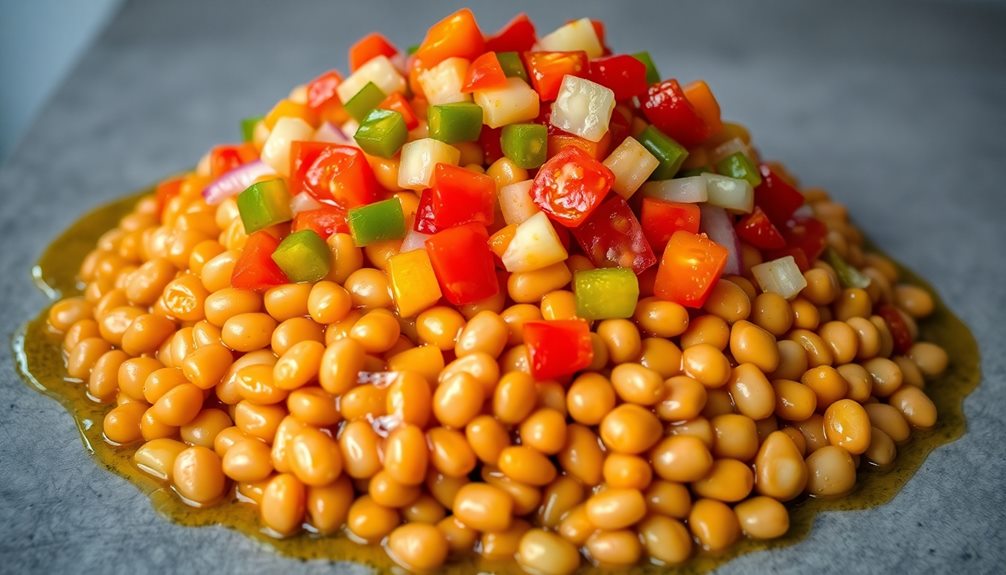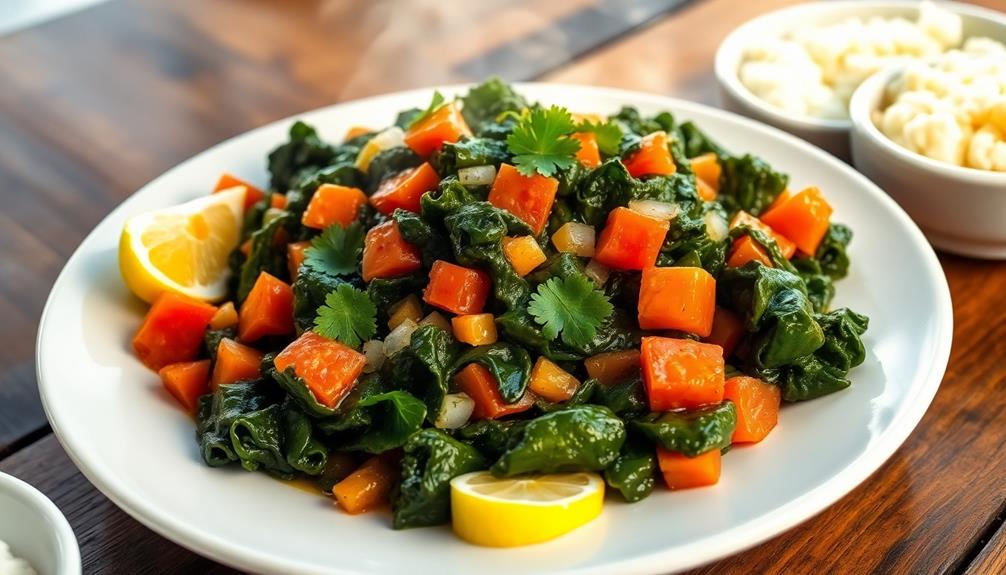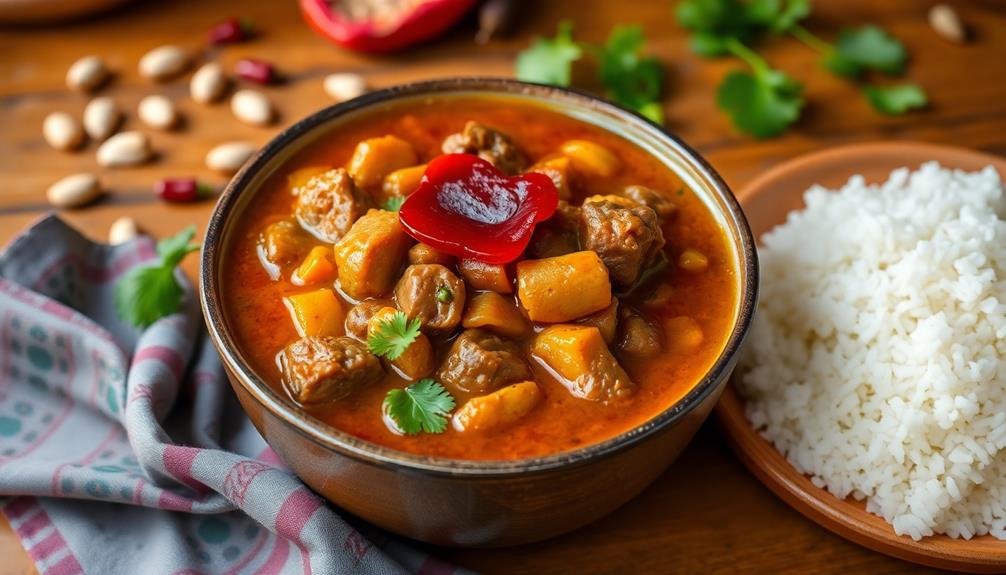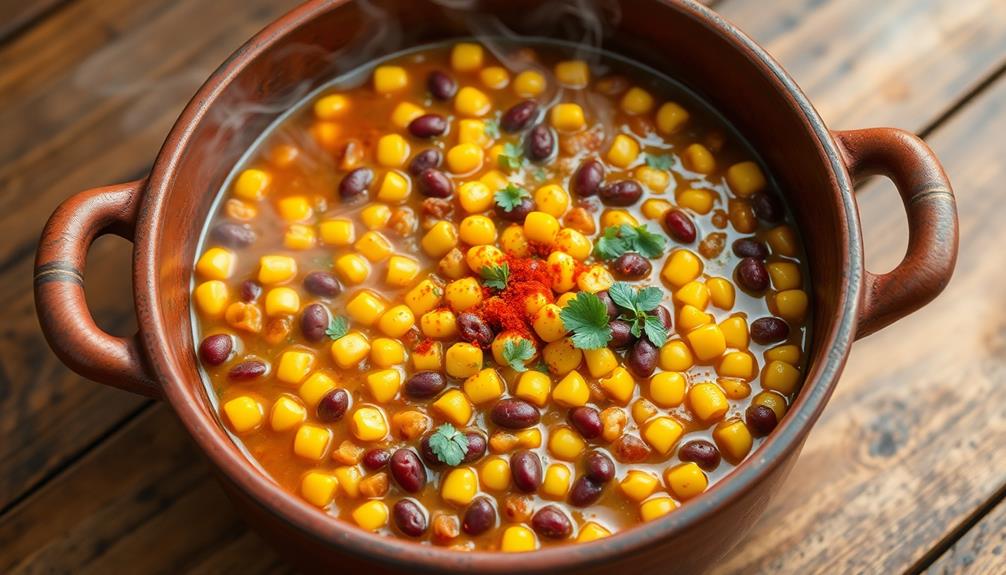Ugba, the fermented African oil bean salad, is a traditional Nigerian dish with a rich cultural heritage. The Igbo people have passed down the unique fermentation process for generations, showcasing their culinary ingenuity. The umami-rich taste of the fermented beans, combined with fresh vegetables and a vibrant dressing, creates a refreshing and nutritious salad. You'll love how the careful preparation and seasoning bring out the remarkable depth of flavor in this dish. With its vibrant colors and appealing presentation, ugba salad is a delightful treat that represents the rich tapestry of African culinary traditions. Intrigued? Keep reading to learn the step-by-step cooking process.
Key Takeaways
- Ugba is a traditional Nigerian salad with a rich cultural heritage, integral to the lives of the Igbo people.
- The fermentation process of the African oil bean seeds is passed down through generations, showcasing culinary ingenuity.
- Ugba's popularity has spread across Nigeria, becoming a beloved dish that represents the rich tapestry of African culinary traditions.
- The cooking process involves boiling, draining, and slicing the oil bean seeds, then marinating them in a blend of spices.
- Ugba salad offers a refreshing and nutritious dish with a unique umami-rich taste from the fermented African oil bean.
History

Ugba, a traditional Nigerian salad, has a rich cultural heritage that dates back centuries. Originally, the oil bean tree was an integral part of the lives of the Igbo people, who used its seeds, leaves, and bark for various purposes.
The process of fermenting and preparing the ugba salad was passed down through generations, becoming a beloved dish that showcased the resourcefulness and culinary ingenuity of the Igbo community.
Over time, the popularity of ugba spread beyond its regional origins, making its way into the kitchens of households across Nigeria. Today, this flavorful salad is enjoyed not only as a delicious side dish but also as a testament to the rich tapestry of African culinary traditions.
The fermentation process, which involves soaking, boiling, and fermenting the oil bean seeds, imparts a unique nutty flavor and firm texture that makes ugba a truly remarkable and versatile ingredient.
Cooking Steps

To begin the cooking process, gather all the necessary ingredients and equipment. You'll need a cutting board, a sharp knife, a large bowl, and a whisk or fork. For the salad, you'll be using ugba (fermented African oil bean), onions, tomatoes, peppers, and a few other fresh veggies.
First, rinse the ugba under cold water and let it drain. Then, thinly slice the onions, dice the tomatoes, and chop the peppers. Add all the chopped veggies to the large bowl.
Next, prepare the dressing. In a small bowl, whisk together some olive oil, lemon juice, salt, and pepper. Pour the dressing over the salad and toss everything together until the ingredients are evenly coated.
Let the salad sit for a few minutes to allow the flavors to meld. Then, serve and enjoy your delicious ugba salad! The combination of the savory ugba, crunchy veggies, and tangy dressing creates a refreshing and satisfying meal.
Step 1. Boil the Oil Bean Seeds
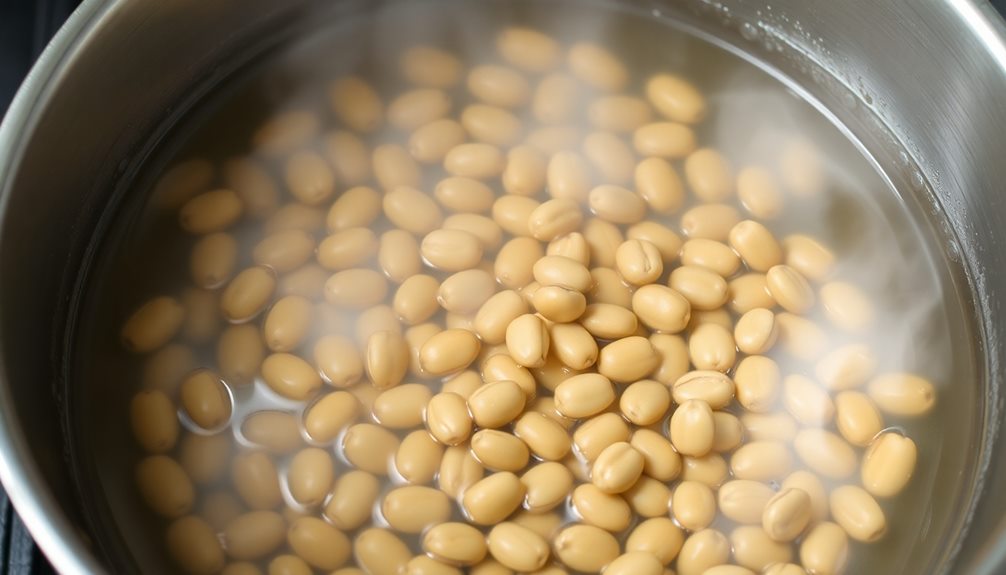
The oil bean seeds, the backbone of this vibrant salad, require a straightforward boiling process to unlock their earthy flavors.
Start by gathering the seeds and giving them a good rinse under cool running water. This helps remove any debris or impurities.
Next, place the seeds in a pot and cover them with plenty of fresh water. Bring the water to a boil over high heat, then reduce the heat to medium-low and let the seeds simmer for about 30 minutes.
You'll know they're ready when you can easily pierce them with a fork. Drain the seeds and rinse them one more time.
Now they're prepped and ready to be transformed into the star of your delicious ugba salad! The boiling step softens the seeds and mellows their distinctive taste, making them the perfect base for all the vibrant flavors to come.
Get ready to experience the delightful crunch and rich, savory goodness of this African delicacy.
Step 2. Drain and Rinse the Seeds

After the oil bean seeds have finished simmering for about 30 minutes, you'll want to drain and rinse them.
Place a colander in the sink and carefully pour the cooked seeds into it, allowing the hot water to drain away. Once the seeds have drained, give them a good rinse under cool, running water. This will help remove any remaining cooking liquid and prepare the seeds for the next step.
As you rinse the seeds, you may notice a thin, papery skin starting to peel off. That's perfectly normal – just gently rub the seeds between your fingers to help remove the skins.
Don't worry if you can't get every bit of skin off; the important thing is to get the seeds nice and clean. Once they're rinsed, give the colander a gentle shake to remove any excess water.
The drained and rinsed seeds are now ready to be used in your delicious Ugba salad. Get ready for the incredible flavor and texture that's about to come!
Step 3. Slice the Fermented Oil Bean Seeds

With the seeds drained and rinsed, you'll want to slice them into thin pieces. Using a sharp knife, carefully cut each fermented oil bean seed into thin, even slices. This will help them cook evenly and give your salad a nice texture.
Don't worry if the slices aren't perfect – a little unevenness adds character! As you slice, you'll notice the seeds have a firm, almost crunchy texture. This is normal and exactly what you want.
The slicing process might take a bit of time, but it's an important step that will pay off in the end. Once all the seeds are sliced, you can move on to the next step of preparing your delicious ugba salad.
The thinly sliced seeds will be the star of the show, so take your time and do it right. With a little patience, you'll have perfectly prepped oil beans ready to be tossed with the other fresh ingredients.
Step 4. Marinate Fermented Seeds in Spices

Now that you've sliced the fermented oil bean seeds, it's time to marinate them in a flavorful spice mixture. Start by gathering your favorite seasonings – maybe some cayenne pepper, garlic powder, and onion flakes. Sprinkle these over the sliced ugba and give everything a good stir.
The next step is to add a bit of oil and lemon juice. You want just enough to coat the seeds and help the spices stick. Mix it all together until the ugba is nicely seasoned. Don't be afraid to get your hands in there and give it a good massage. This helps the flavors really soak into the beans.
Now, let the marinated ugba sit for about 15 minutes. This allows the spices to meld and the seeds to absorb all that delicious seasoning.
When the time's up, give it one last gentle stir. Your ugba salad is now ready to enjoy! The vibrant colors and tantalizing aromas will have your mouth watering in no time.
Step 5. Add Desired Seasonings
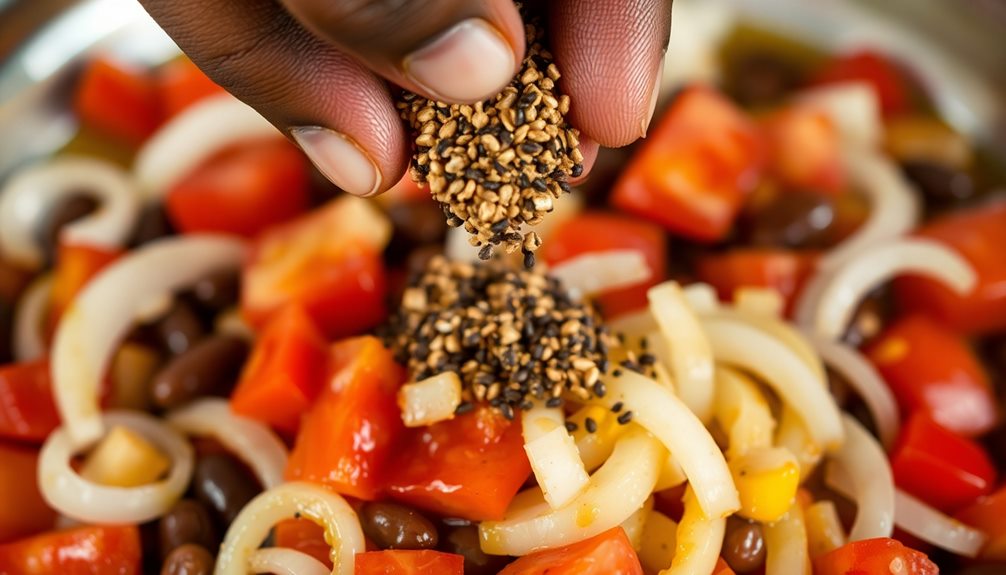
Gather your desired seasonings – perhaps a touch of cayenne pepper for heat, garlic powder for savory depth, and onion flakes for a hint of sweetness.
These spices will enhance the already bold flavor of the fermented ugba seeds. Start by adding a pinch or two of your chosen seasonings, then give the salad a gentle stir to incorporate them evenly.
Taste as you go, adjusting the amounts to suit your preferences. Don't be afraid to experiment! You can also try other spices like smoked paprika, cumin, or dried herbs. The possibilities are endless.
Remember, the key is to find the perfect balance of flavors that tantalizes your taste buds. With a little trial and error, you'll have a delightful ugba salad that's seasoned to perfection.
Serve it chilled or at room temperature, and enjoy the complex, satisfying flavors in every bite.
Final Thoughts

Ultimately, the Ugba Salad is a refreshing and nutritious dish that offers a delightful balance of flavors and textures. The fermented African oil bean, or Ugba, gives the salad a unique umami-rich taste that pairs perfectly with the crunchy vegetables and tangy dressing.
Whether you enjoy it as a light meal or a flavorful side, this salad is sure to delight your taste buds. As you savor each bite, you'll appreciate the care and attention that goes into preparing this traditional African dish.
The careful fermentation process and the blend of spices and seasonings create a depth of flavor that's truly remarkable. And with its vibrant colors and appealing presentation, the Ugba Salad isn't just delicious but a feast for the eyes as well.
Frequently Asked Questions
What Are the Health Benefits of Consuming Ugba?
Consuming ugba can provide you with essential nutrients like protein, fiber, and vitamins. It may also support digestion, boost your immune system, and lower your risk of chronic diseases. Incorporating this fermented food into your diet can be a healthy choice.
How Long Does Ugba Keep After It Has Been Prepared?
Once prepared, ugba will typically keep for 3-5 days when stored in the refrigerator. To maximize its shelf life, be sure to store it in an airtight container and consume it within this timeframe.
What Are the Best Ways to Serve Ugba as a Salad?
You can serve ugba as a salad in various ways – toss it with fresh vegetables, mix it with a tangy dressing, or use it as a topping for your favorite greens. Get creative and enjoy its unique flavor!
Can Ugba Be Used in Other African Dishes Besides Salads?
Absolutely! Ugba can be incorporated into various African dishes beyond just salads. You can use it to add texture and flavor to stews, rice dishes, and even as a topping for grilled meats or roasted vegetables.
Are There Any Variations in the Recipe for Ugba Across West Africa?
Yes, there are variations in the ugba recipe across West Africa. Each region has its own unique twist, using local ingredients and techniques to create distinctive flavors and textures in this fermented oil bean dish.
